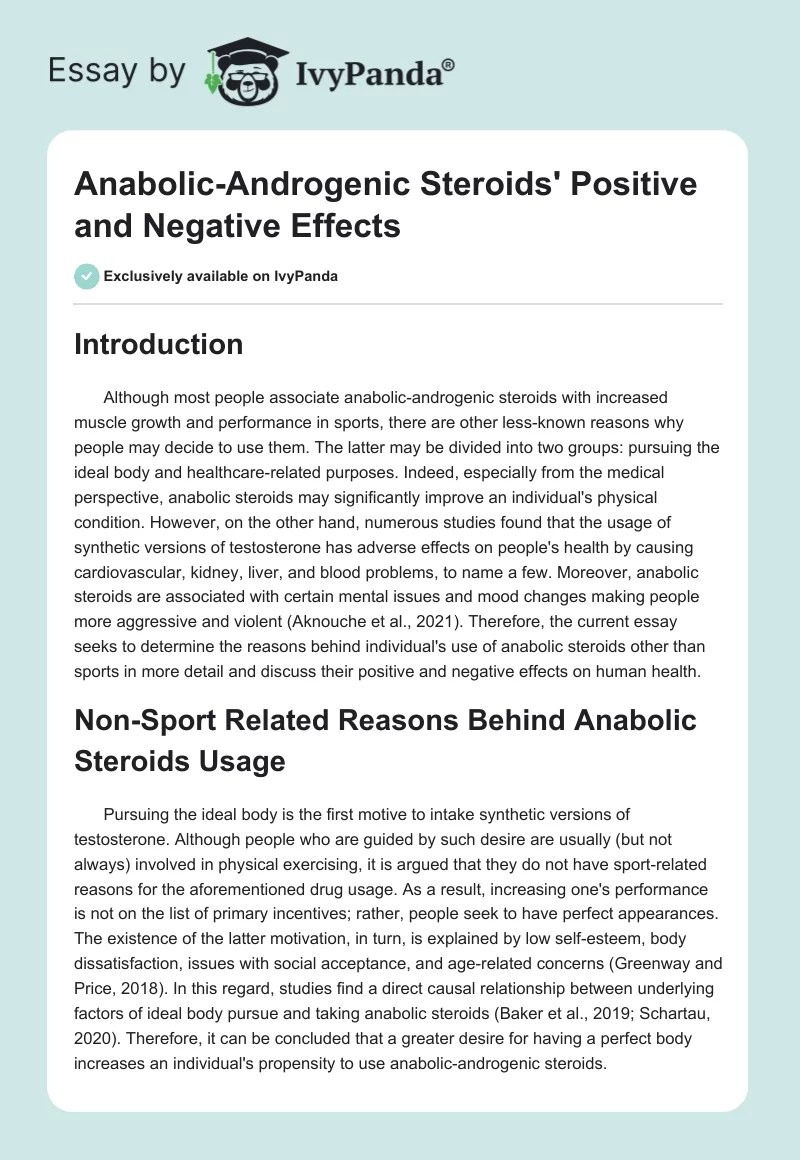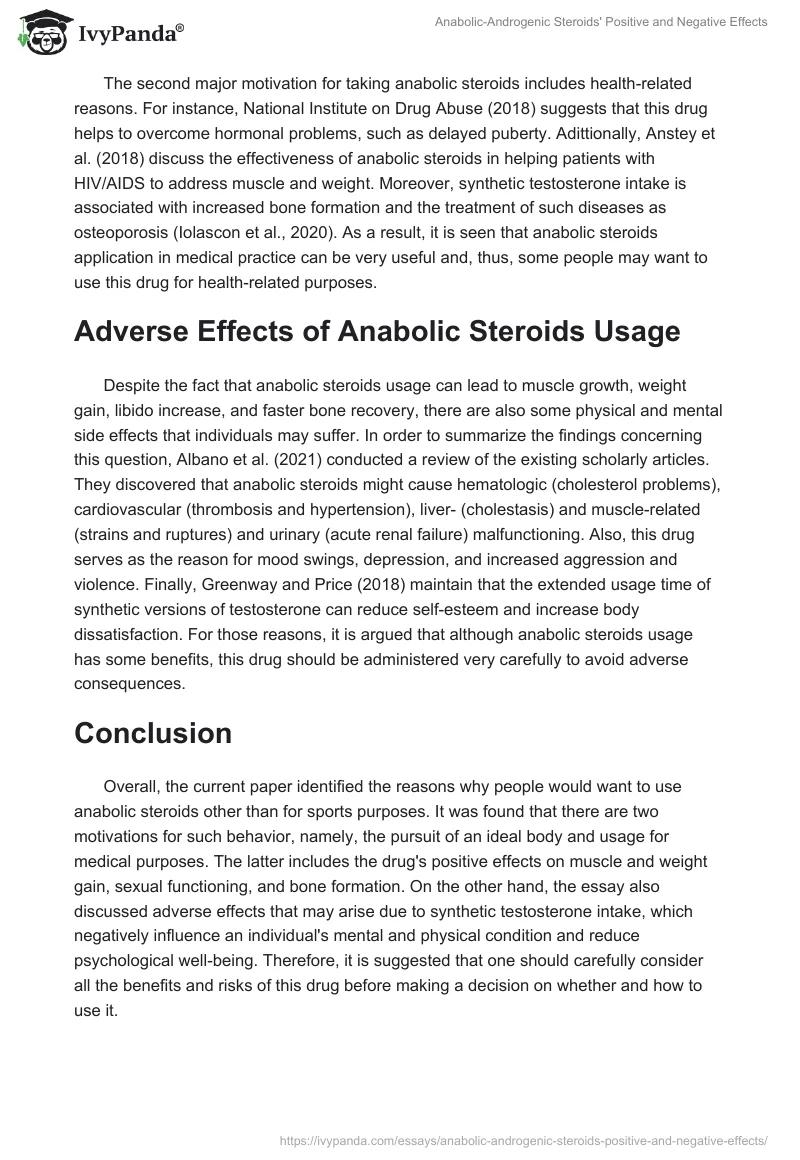Introduction
Although most people associate anabolic-androgenic steroids with increased muscle growth and performance in sports, there are other less-known reasons why people may decide to use them. The latter may be divided into two groups: pursuing the ideal body and healthcare-related purposes. Indeed, especially from the medical perspective, anabolic steroids may significantly improve an individual’s physical condition. However, on the other hand, numerous studies found that the usage of synthetic versions of testosterone has adverse effects on people’s health by causing cardiovascular, kidney, liver, and blood problems, to name a few. Moreover, anabolic steroids are associated with certain mental issues and mood changes making people more aggressive and violent (Aknouche et al., 2021). Therefore, the current essay seeks to determine the reasons behind individual’s use of anabolic steroids other than sports in more detail and discuss their positive and negative effects on human health.
Non-Sport Related Reasons Behind Anabolic Steroids Usage
Pursuing the ideal body is the first motive to intake synthetic versions of testosterone. Although people who are guided by such desire are usually (but not always) involved in physical exercising, it is argued that they do not have sport-related reasons for the aforementioned drug usage. As a result, increasing one’s performance is not on the list of primary incentives; rather, people seek to have perfect appearances. The existence of the latter motivation, in turn, is explained by low self-esteem, body dissatisfaction, issues with social acceptance, and age-related concerns (Greenway and Price, 2018). In this regard, studies find a direct causal relationship between underlying factors of ideal body pursue and taking anabolic steroids (Baker et al., 2019; Schartau, 2020). Therefore, it can be concluded that a greater desire for having a perfect body increases an individual’s propensity to use anabolic-androgenic steroids.
The second major motivation for taking anabolic steroids includes health-related reasons. For instance, National Institute on Drug Abuse (2018) suggests that this drug helps to overcome hormonal problems, such as delayed puberty. Adittionally, Anstey et al. (2018) discuss the effectiveness of anabolic steroids in helping patients with HIV/AIDS to address muscle and weight. Moreover, synthetic testosterone intake is associated with increased bone formation and the treatment of such diseases as osteoporosis (Iolascon et al., 2020). As a result, it is seen that anabolic steroids application in medical practice can be very useful and, thus, some people may want to use this drug for health-related purposes.
Adverse Effects of Anabolic Steroids Usage
Despite the fact that anabolic steroids usage can lead to muscle growth, weight gain, libido increase, and faster bone recovery, there are also some physical and mental side effects that individuals may suffer. In order to summarize the findings concerning this question, Albano et al. (2021) conducted a review of the existing scholarly articles. They discovered that anabolic steroids might cause hematologic (cholesterol problems), cardiovascular (thrombosis and hypertension), liver- (cholestasis) and muscle-related (strains and ruptures) and urinary (acute renal failure) malfunctioning. Also, this drug serves as the reason for mood swings, depression, and increased aggression and violence. Finally, Greenway and Price (2018) maintain that the extended usage time of synthetic versions of testosterone can reduce self-esteem and increase body dissatisfaction. For those reasons, it is argued that although anabolic steroids usage has some benefits, this drug should be administered very carefully to avoid adverse consequences.
Conclusion
Overall, the current paper identified the reasons why people would want to use anabolic steroids other than for sports purposes. It was found that there are two motivations for such behavior, namely, the pursuit of an ideal body and usage for medical purposes. The latter includes the drug’s positive effects on muscle and weight gain, sexual functioning, and bone formation. On the other hand, the essay also discussed adverse effects that may arise due to synthetic testosterone intake, which negatively influence an individual’s mental and physical condition and reduce psychological well-being. Therefore, it is suggested that one should carefully consider all the benefits and risks of this drug before making a decision on whether and how to use it.
References
Aknouche, F., Gheddar, L., Kernalléguen, A., Maruejouls, C., & Kintz, P. (2021). Anabolic steroids and extreme violence: A case of murder after chronic intake and under acute influence of metandienone and trenbolone. International Journal of Legal Medicine, 135, 1449 – 1453.
Albano, G.D., Amico, F., Cocimano, G., Liberto, A., Maglietta, F., Esposito, M., Rosi, G.L., Di Nunno, N., Salerno, M. & Montana, A. (2021). Adverse effects of anabolic-androgenic steroids: A literature review. Healthcare, 9(1), 97-116.
Anstey, M., Desai, S., Torre, L., Wibrow, B., Seet, J., & Osnain, E. (2018). Anabolic steroid use for weight and strength gain in critically ill patients: A case series and review of the literature. Case Reports in Critical Care, 2018, 1-6.
Baker, J. H., Higgins Neyland, M. K., Thornton, L. M., Runfola, C. D., Larsson, H., Lichtenstein, P., & Bulik, C. (2019). Body dissatisfaction in adolescent boys. Developmental Psychology, 55(7), 1566-1578.
Greenway, C. W., & Price, C. (2018). A qualitative study of the motivations for anabolic-androgenic steroid use: The role of muscle dysmorphia and self-esteem in long-term users. Performance Enhancement & Health, 6(1), 12-20.
Iolascon, G., Moretti, A., Toro, G., Gimigliano, F., Liguori, S., & Paoletta, M. (2020). Pharmacological therapy of osteoporosis: What’s new? Clinical Interventions in Aging, 15, 485-491.
National Institute on Drug Abuse. (2018). Anabolic steroids drugfacts.
Schartau, P. (2020). Britain’s anabolic steroid epidemic. Trends in Urology & Men’s Health, 11(4), 27-30a.


